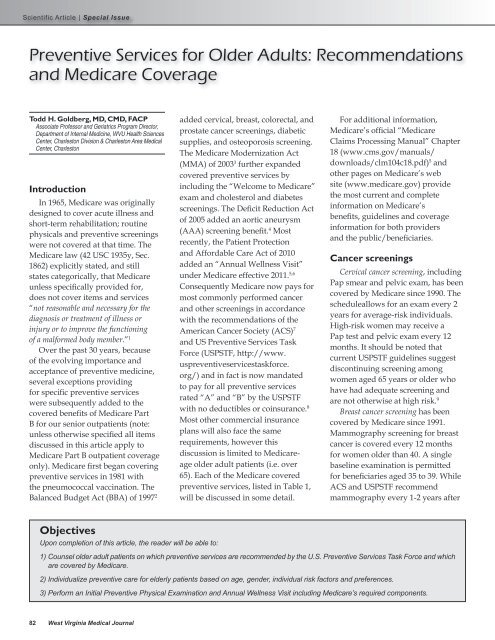Special CME Issue - West Virginia State Medical Association
Special CME Issue - West Virginia State Medical Association
Special CME Issue - West Virginia State Medical Association
You also want an ePaper? Increase the reach of your titles
YUMPU automatically turns print PDFs into web optimized ePapers that Google loves.
Preventive Services for Older Adults: Recommendations<br />
and Medicare Coverage<br />
Todd H. Goldberg, MD, CMD, FACP<br />
Associate Professor and Geriatrics Program Director,<br />
Department of Internal Medicine, WVU Health Sciences<br />
Center, Charleston Division & Charleston Area <strong>Medical</strong><br />
Center, Charleston<br />
Introduction<br />
In 1965, Medicare was originally<br />
designed to cover acute illness and<br />
short-term rehabilitation; routine<br />
physicals and preventive screenings<br />
were not covered at that time. The<br />
Medicare law (42 USC 1935y, Sec.<br />
1862) explicitly stated, and still<br />
states categorically, that Medicare<br />
unless specifically provided for,<br />
does not cover items and services<br />
“not reasonable and necessary for the<br />
diagnosis or treatment of illness or<br />
injury or to improve the functioning<br />
of a malformed body member.” 1<br />
Over the past 30 years, because<br />
of the evolving importance and<br />
acceptance of preventive medicine,<br />
several exceptions providing<br />
for specific preventive services<br />
were subsequently added to the<br />
covered benefits of Medicare Part<br />
B for our senior outpatients (note:<br />
unless otherwise specified all items<br />
discussed in this article apply to<br />
Medicare Part B outpatient coverage<br />
only). Medicare first began covering<br />
preventive services in 1981 with<br />
the pneumococcal vaccination. The<br />
Balanced Budget Act (BBA) of 1997 2<br />
added cervical, breast, colorectal, and<br />
prostate cancer screenings, diabetic<br />
supplies, and osteoporosis screening.<br />
The Medicare Modernization Act<br />
(MMA) of 2003 3 further expanded<br />
covered preventive services by<br />
including the “Welcome to Medicare”<br />
exam and cholesterol and diabetes<br />
screenings. The Deficit Reduction Act<br />
of 2005 added an aortic aneurysm<br />
(AAA) screening benefit. 4 Most<br />
recently, the Patient Protection<br />
and Affordable Care Act of 2010<br />
added an “Annual Wellness Visit”<br />
under Medicare effective 2011. 5,6<br />
Consequently Medicare now pays for<br />
most commonly performed cancer<br />
and other screenings in accordance<br />
with the recommendations of the<br />
American Cancer Society (ACS) 7<br />
and US Preventive Services Task<br />
Force (USPSTF, http://www.<br />
uspreventiveservicestaskforce.<br />
org/) and in fact is now mandated<br />
to pay for all preventive services<br />
rated “A” and “B” by the USPSTF<br />
with no deductibles or coinsurance. 8<br />
Most other commercial insurance<br />
plans will also face the same<br />
requirements, however this<br />
discussion is limited to Medicareage<br />
older adult patients (i.e. over<br />
65). Each of the Medicare covered<br />
preventive services, listed in Table 1,<br />
will be discussed in some detail.<br />
For additional information,<br />
Medicare’s official “Medicare<br />
Claims Processing Manual” Chapter<br />
18 (www.cms.gov/manuals/<br />
downloads/clm104c18.pdf) 5 and<br />
other pages on Medicare’s web<br />
site (www.medicare.gov) provide<br />
the most current and complete<br />
information on Medicare’s<br />
benefits, guidelines and coverage<br />
information for both providers<br />
and the public/beneficiaries.<br />
Cancer screenings<br />
Cervical cancer screening, including<br />
Pap smear and pelvic exam, has been<br />
covered by Medicare since 1990. The<br />
scheduleallows for an exam every 2<br />
years for average-risk individuals.<br />
High-risk women may receive a<br />
Pap test and pelvic exam every 12<br />
months. It should be noted that<br />
current USPSTF guidelines suggest<br />
discontinuing screening among<br />
women aged 65 years or older who<br />
have had adequate screening and<br />
are not otherwise at high risk. 9<br />
Breast cancer screening has been<br />
covered by Medicare since 1991.<br />
Mammography screening for breast<br />
cancer is covered every 12 months<br />
for women older than 40. A single<br />
baseline examination is permitted<br />
for beneficiaries aged 35 to 39. While<br />
ACS and USPSTF recommend<br />
mammography every 1-2 years after<br />
Objectives<br />
Upon completion of this article, the reader will be able to:<br />
1) Counsel older adult patients on which preventive services are recommended by the U.S. Preventive Services Task Force and which<br />
are covered by Medicare.<br />
2) Individualize preventive care for elderly patients based on age, gender, individual risk factors and preferences.<br />
3) Perform an Initial Preventive Physical Examination and Annual Wellness Visit including Medicare’s required components.<br />
82 <strong>West</strong> <strong>Virginia</strong> <strong>Medical</strong> Journal















